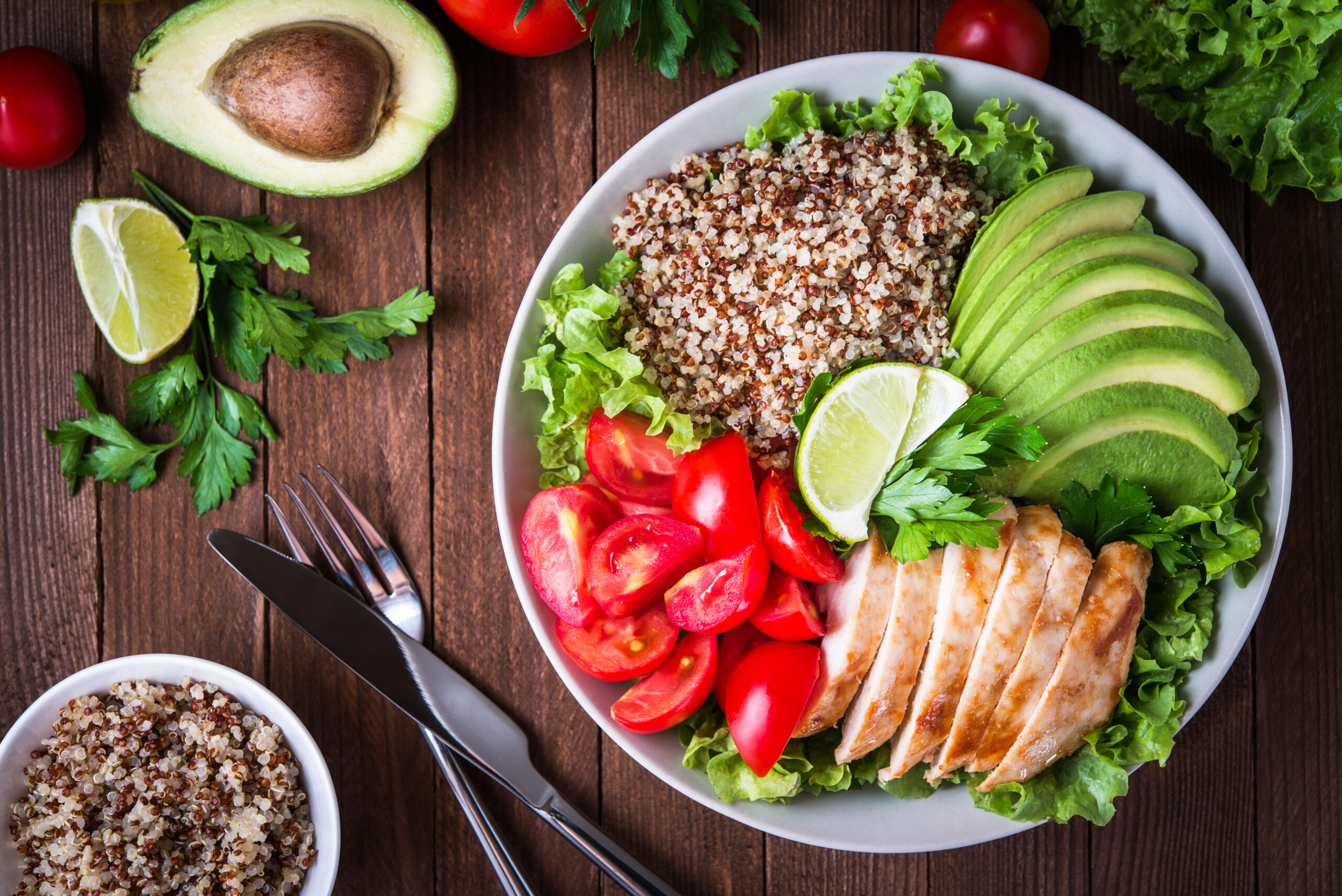One of the best ways to support your health and wellbeing is to fill your diet with nutrient rich foods. Meal planning is a great way to ensure you eat a wide variety of nutrients. Though it may sound daunting, meal planning can be as straightforward or as sophisticated as you’d like it to be, it just depends on your health and fitness goals.
For general health and wellness, I recommend a simple approach to meal planning that will help you improve the quality of your diet. For those of you interested in this approach, here are five things to consider when building your meals:
- Complex carbs when possible
- Little added sugar (<10% of total calories, which equals 30-50g for a 1,200-2,000 calorie diet)
- Some protein (~5-10g/snack; ~20-30g/meal)
- Increased unsaturated fats
- Micronutrients and phytonutrients
To reach more specific health and fitness goals, I suggest a more involved approach to meal planning that focuses on both nutrient quality and quantity. For those of you interested in this approach, you will need to consider the five things listed above to improve the quality of your diet and look at your macronutrient intake.
Meal planning with macros
Your macronutrient intake is the amount of carbohydrates, protein, and fat you consume on a daily basis. Macronutrients are measured in two ways: calories and grams. A calorie is a measurement of the amount of energy provided by a nutrient. A gram is a measurement of mass, which describes the number of particles in an object.
There are roughly four calories per gram of carbohydrate and protein. There are nine calories per gram of fat. The higher calorie content of fat means it provides more energy per gram than carbohydrates and protein.
Monitoring your macronutrient intake can be helpful when working towards your health and fitness goals. Counting your macros, either in calories or grams, provides a useful way to see how much energy you get from food. Eat too much and you put yourself in a positive energy balance (good for muscle building, not-so-good for weight loss). Eat too little and you put yourself in a negative energy balance (great for weight loss, not-so-great for physical performance).
Energy balance is a key component of any health and fitness regimen. To achieve your desired results, you must balance your energy consumption (how many calories you eat) with your energy expenditure (how many calories you burn).
Determining how much to eat
After years of working as a meal planning nutritionist, I have found a macronutrient breakdown that has helped many people achieve energy balance and reach their desired health and fitness goals.
Here is what I suggest for most healthy people. If you have underlying health conditions, please reach out to me or speak with your healthcare provider to determine if this dietary approach is safe for you.
- Determine your total calorie needs. For an approximate value, use the Harris-Benedict calculator (found here). For a more exact calculation of your calorie needs, send me a message via email – liveeattrain@gmail.com. Please provide your name, height, weight, daily activity level [sedentary (sitting most of the day) or active (standing or moving most of the day)], the number of days you exercise per week, as well as exercise intensity and duration.
- Calculate your protein intake. I feel that most people can benefit from a protein intake of ~1.7 g/kg. Multiply this number by 4 to convert to calories.
- Calculate your fat intake, which should be ~23% of your total calorie intake. Divide this number by 9 if you’d like to convert to grams of fat.
- Calculate your carbohydrate intake by adding together the calories of protein and fat found in the steps above. Subtract that number from your total calorie needs. Divide by 4 if you’d like to convert to grams of carbohydrates.
Using this method, your protein intake will be ~23% of your total calories, fat will be ~20-25%, and carbohydrates will be ~50%.
|
Carbohydrates |
Protein |
Fat |
|
|
Calories (kcals) |
~50% | ~20-25% |
~23% |
|
Grams |
Total kcals – (Protein kcals + Fat kcals)/4 | 1.7 g/kg | (Total kcals)(0.23)/9 |
| Grams per meal (3/day) | ~50g | 20-30g |
15-20g |
| Grams per snack (2/day) |
~25g |
5-20g |
5-10g |
Though not considered macronutrients, two other things I recommend keeping track of are your fiber and added sugar intake. Shoot for ~30 grams per day of fiber. This works out to be ~7 grams per meal. Try to limit your added sugar intake to less than 10% of your daily calories. For a 1,200-2,000 calorie diet, this works out to be 30-50 grams per day.
The takeaway
A nutritious diet is an essential component of a healthy lifestyle. For general health and wellness, focus on improving the quality of your diet to reach your goals. To achieve more specific health and fitness goals, energy balance becomes important, which means considering how much you eat on a daily basis. Meal planning with macros is an effective way to monitor your energy consumption and can be accomplished by using the guidance provided above.



